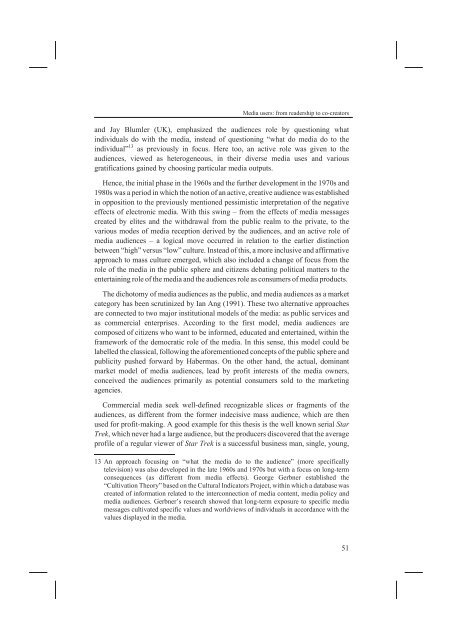D:\Documents and Settings\Ana\My Documents\Biserka-knjiga ...
D:\Documents and Settings\Ana\My Documents\Biserka-knjiga ...
D:\Documents and Settings\Ana\My Documents\Biserka-knjiga ...
You also want an ePaper? Increase the reach of your titles
YUMPU automatically turns print PDFs into web optimized ePapers that Google loves.
Media users: from readership to co-creators<br />
<strong>and</strong> Jay Blumler (UK), emphasized the audiences role by questioning what<br />
individuals do with the media, instead of questioning “what do media do to the<br />
individual” 13 as previously in focus. Here too, an active role was given to the<br />
audiences, viewed as heterogeneous, in their diverse media uses <strong>and</strong> various<br />
gratifications gained by choosing particular media outputs.<br />
Hence, the initial phase in the 1960s <strong>and</strong> the further development in the 1970s <strong>and</strong><br />
1980s was a period in which the notion of an active, creative audience was established<br />
in opposition to the previously mentioned pessimistic interpretation of the negative<br />
effects of electronic media. With this swing – from the effects of media messages<br />
created by elites <strong>and</strong> the withdrawal from the public realm to the private, to the<br />
various modes of media reception derived by the audiences, <strong>and</strong> an active role of<br />
media audiences – a logical move occurred in relation to the earlier distinction<br />
between “high” versus “low” culture. Instead of this, a more inclusive <strong>and</strong> affirmative<br />
approach to mass culture emerged, which also included a change of focus from the<br />
role of the media in the public sphere <strong>and</strong> citizens debating political matters to the<br />
entertaining role of the media <strong>and</strong> the audiences role as consumers of media products.<br />
The dichotomy of media audiences as the public, <strong>and</strong> media audiences as a market<br />
category has been scrutinized by Ian Ang (1991). These two alternative approaches<br />
are connected to two major institutional models of the media: as public services <strong>and</strong><br />
as commercial enterprises. According to the first model, media audiences are<br />
composed of citizens who want to be informed, educated <strong>and</strong> entertained, within the<br />
framework of the democratic role of the media. In this sense, this model could be<br />
labelled the classical, following the aforementioned concepts of the public sphere <strong>and</strong><br />
publicity pushed forward by Habermas. On the other h<strong>and</strong>, the actual, dominant<br />
market model of media audiences, lead by profit interests of the media owners,<br />
conceived the audiences primarily as potential consumers sold to the marketing<br />
agencies.<br />
Commercial media seek well-defined recognizable slices or fragments of the<br />
audiences, as different from the former indecisive mass audience, which are then<br />
used for profit-making. A good example for this thesis is the well known serial Star<br />
Trek, which never had a large audience, but the producers discovered that the average<br />
profile of a regular viewer of Star Trek is a successful business man, single, young,<br />
13 An approach focusing on “what the media do to the audience” (more specifically<br />
television) was also developed in the late 1960s <strong>and</strong> 1970s but with a focus on long-term<br />
consequences (as different from media effects). George Gerbner established the<br />
“Cultivation Theory” based on the Cultural Indicators Project, within which a database was<br />
created of information related to the interconnection of media content, media policy <strong>and</strong><br />
media audiences. Gerbner’s research showed that long-term exposure to specific media<br />
messages cultivated specific values <strong>and</strong> worldviews of individuals in accordance with the<br />
values displayed in the media.<br />
51



